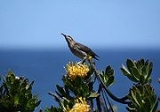
Cape Sugarbird
Encyclopedia
The Cape Sugarbird, Promerops cafer, is one of the six bird species endemic to the Fynbos
biome
of the Western Cape and Eastern Cape
provinces of South Africa
.
s and erica
s. It is also found in gardens in summer when most proteas are not in flower. A common species throughout its range, the Cape Sugarbird is evaluated as Least Concern on the IUCN Red List
of Threatened Species.
. Its long, sharp beak is used to reach the nectar of a variety of species of protea with its long brush-tipped tongue. The staple diet of this sugarbird
is nectar; however, it will also eat spiders and insects. The characteristic strong winds in the Cape
may make feeding off protea heads difficult, but the Cape Sugarbird has adapted to this with the development of sharp claws.
Fynbos
Fynbos is the natural shrubland or heathland vegetation occurring in a small belt of the Western Cape of South Africa, mainly in winter rainfall coastal and mountainous areas with a Mediterranean climate...
biome
Biome
Biomes are climatically and geographically defined as similar climatic conditions on the Earth, such as communities of plants, animals, and soil organisms, and are often referred to as ecosystems. Some parts of the earth have more or less the same kind of abiotic and biotic factors spread over a...
of the Western Cape and Eastern Cape
Eastern Cape
The Eastern Cape is a province of South Africa. Its capital is Bhisho, but its two largest cities are Port Elizabeth and East London. It was formed in 1994 out of the "independent" Xhosa homelands of Transkei and Ciskei, together with the eastern portion of the Cape Province...
provinces of South Africa
South Africa
The Republic of South Africa is a country in southern Africa. Located at the southern tip of Africa, it is divided into nine provinces, with of coastline on the Atlantic and Indian oceans...
.
Description
The Cape Sugarbird is a grey-brown bird that easily recognisable by a spot of yellow under its tail and the very long tail feathers present in males. The male is 34–44 cm long, and the shorter-tailed, shorter-billed, and paler breasted female 25–29 cm long. Another characteristic of the Cape Sugarbird is the sound it makes when it flies. The main flight feathers are arranged in such a way that when the bird beats its wings, a frrt-frrt sound is made with the intention of attracting females.Distribution and status
The Cape Sugarbird is distributed throughout the chaparral in South Africa and the Cape Floral Region where there are flowering proteaProtea
Protea is both the botanical name and the English common name of a genus of flowering plants, sometimes also called sugarbushes.-Etymology:...
s and erica
Erica
Erica ,the heaths or heathers, is a genus of approximately 860 species of flowering plants in the family Ericaceae. The English common names "heath" and "heather" are shared by some closely related genera of similar appearance....
s. It is also found in gardens in summer when most proteas are not in flower. A common species throughout its range, the Cape Sugarbird is evaluated as Least Concern on the IUCN Red List
IUCN Red List
The IUCN Red List of Threatened Species , founded in 1963, is the world's most comprehensive inventory of the global conservation status of biological species. The International Union for Conservation of Nature is the world's main authority on the conservation status of species...
of Threatened Species.
Food and feeding
The Cape Sugarbird is a specialist nectar feeder when it comes to feeding off ProteaceaeProteaceae
Proteaceae is a family of flowering plants distributed in the Southern Hemisphere. The family comprises about 80 genera with about 1600 species. Together with the Platanaceae and Nelumbonaceae they make up the order Proteales. Well known genera include Protea, Banksia, Embothrium, Grevillea,...
. Its long, sharp beak is used to reach the nectar of a variety of species of protea with its long brush-tipped tongue. The staple diet of this sugarbird
Sugarbird
The sugarbirds are a small family, Promeropidae, of passerine birds which are restricted to southern Africa. The two species of sugarbird make up one of only two bird families restricted entirely to southern Africa, the other being the rock-jumpers Chaetopidae...
is nectar; however, it will also eat spiders and insects. The characteristic strong winds in the Cape
Cape Province
The Province of the Cape of Good Hope was a province in the Union of South Africa and subsequently the Republic of South Africa...
may make feeding off protea heads difficult, but the Cape Sugarbird has adapted to this with the development of sharp claws.

